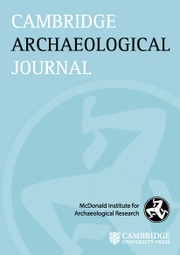Crossref Citations
This article has been cited by the following publications. This list is generated based on data provided by
Crossref.
Guengerich, Anna
2014.
The architect’s signature: The social production of a residential landscape at Monte Viudo, Chachapoyas, Peru.
Journal of Anthropological Archaeology,
Vol. 34,
Issue. ,
p.
1.
Harrison‐Buck, Eleanor
2014.
Anthropological Archaeology in 2013: The Search for Truth(s).
American Anthropologist,
Vol. 116,
Issue. 2,
p.
338.
Kolozali, Hulya
2016.
Materiality and Architecture: Potential Strategy for Achieving Sustainable Design.
Procedia Environmental Sciences,
Vol. 34,
Issue. ,
p.
212.
Guengerich, Anna
2017.
Domestic architecture and the materiality of public-making in pre-Columbian Eastern Peru.
Journal of Social Archaeology,
Vol. 17,
Issue. 3,
p.
263.
Amadio, Marialucia
2018.
From deposits to social practices: Integrated micromorphological analysis of floor sequences at Middle Bronze Age Erimi-Laonin tou Porakou, Cyprus.
Journal of Archaeological Science: Reports,
Vol. 21,
Issue. ,
p.
433.
O’Grady, Caitlin R.
Luke, Christina
Mokrišová, Jana
Roosevelt, Christopher H.
and
Geraghty, Lincoln
2018.
Interdisciplinary approaches to understanding and preserving mudbrick architecture in regional and diachronic contexts.
Cogent Arts & Humanities,
Vol. 5,
Issue. 1,
Eriksen, Marianne Hem
2019.
Architecture, Society, and Ritual in Viking Age Scandinavia.
Devolder, Maud
and
Lorenzon, Marta
2019.
Minoan Master Builders?.
Bulletin de Correspondance Hellénique,
p.
63.
Storozum, Michael J.
Zhang, Junna
Wang, Hui
Ren, Xiaolin
Qin, Zhen
and
Li, Lan
2019.
Geoarchaeology in China: Historical Trends and Future Prospects.
Journal of Archaeological Research,
Vol. 27,
Issue. 1,
p.
91.
2020.
Consciousness, Creativity, and Self at the Dawn of Settled Life.
p.
1.
Rosenberg, Danny
Love, Serena
Hubbard, Emily
Klimscha, Florian
and
Biehl, Peter F.
2020.
7,200 years old constructions and mudbrick technology: The evidence from Tel Tsaf, Jordan Valley, Israel.
PLOS ONE,
Vol. 15,
Issue. 1,
p.
e0227288.
Millaire, Jean-François
2020.
Dating the occupation of Cerro Arena: A defensive Salinar-phase settlement in the Moche Valley, Peru.
Journal of Anthropological Archaeology,
Vol. 57,
Issue. ,
p.
101142.
Maher, Lisa
2020.
Consciousness, Creativity, and Self at the Dawn of Settled Life.
p.
31.
Lorenzon, Marta
Nitschke, Jessica L.
Littman, Robert J.
and
Silverstein, Jay E.
2020.
Mudbricks, Construction Methods, and Stratigraphic Analysis: A Case Study at Tell Timai (Ancient Thmuis) in the Egyptian Delta.
American Journal of Archaeology,
Vol. 124,
Issue. 1,
p.
105.
Mylona, Pantelitsa
Wattez, Julia
and
Vigne, Jean-Denis
2023.
Τhe earthen architecture as a mirror of the Neolithic cultural organization: the case of the PPNA site of Klimonas in Cyprus.
Palethnologie,
Uzdurum, Melis
Schönicke, Julia
Kinzel, Moritz
and
Barański, Marek Z.
2023.
Studying the Use of Earth in Early Architecture of Southwest and Central Asia.
Open Archaeology,
Vol. 9,
Issue. 1,
Kalogiropoulou, Evita
Kloukinas, Dimitris
and
Kotsakis, Kostas
2023.
Socializing the Materiality of Earthen Structures: TheChaîne Opératoireof Construction Practices at the Neolithic Site of Kleitos 2, Greece.
Cambridge Archaeological Journal,
Vol. 33,
Issue. 3,
p.
449.
Kay, Kevin
2023.
The Baby in the Brick: A More-Than-Representational Approach to Architectural Action and Intramural Burial at Çatalhöyük.
Norwegian Archaeological Review,
Vol. 56,
Issue. 1,
p.
1.
Lorenzon, Marta
2023.
Earthen Architecture as a Community of Practice: A Case Study of Neolithic Earthen Production in the Eastern Mediterranean.
Cambridge Archaeological Journal,
Vol. 33,
Issue. 4,
p.
601.


